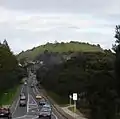Mount Victoria (Auckland)
Takarunga / Mount Victoria is the highest volcano on Auckland's North Shore, rising to 87 m. Its age is currently unknown. Its lava flows now line much of Devonport's waterfront. An important pa (fortification) once occupied its slopes, and some of the pa's earthworks can still be seen.[1] A scoria mound known as Duders Hill, on Takarunga / Mount Victoria's southern slopes was mostly quarried away. The name Mount Victoria comes from Queen Victoria and the name Takarunga means "the hill standing above". Jules Dumont d'Urville climbed the hill in 1827.[2]
| Takarunga | |
|---|---|
| Mount Victoria | |
 Takarunga / Mount Victoria as seen from the south on the Waitematā Harbour, the Devonport ferry terminal in the middle distance. | |
| Highest point | |
| Elevation | 87 m (285 ft) |
| Coordinates | 36.8266°S 174.7990°E |
| Geography | |
| Location | North Island, New Zealand |
| Geology | |
| Volcanic arc/belt | Auckland volcanic field |
The hill provides panoramic views of Auckland's Waitematā Harbour and the inner Hauraki Gulf. Over the years the peak and upper slopes have housed a signal station for shipping,[3] artillery emplacements, farmland, and various concrete army bunkers, some from as early as the 1870s. One bunker now serves as the venue for the Devonport Folk Music Club.[4]
The slopes of Takarunga / Mount Victoria are also home to Devonport Primary School, Takarunga Playcentre, a tennis court, a cemetery, a water reservoir which maintains supply to the area, and a scenic lookout. The old Signalman's House is now home to the Michael King Writers Centre which provides writers-in-residence programmes, hosting for visiting writers, residential workshops for experienced writers, and a series of workshops for young poets and emerging writers.[5] The writer-in-residence programmes are supported by Creative New Zealand and the University of Auckland.[6]
In the 2014 Treaty of Waitangi settlement with the Tamaki Makaurau Collective of 13 Auckland iwi, the volcano was officially named Takarunga / Mount Victoria and ownership was vested to the collective. It is now co-governed by the collective and Auckland Council in common benefit of the iwi "and all other people of Auckland".[7][8][9][10][11][12]
 The north side of Takarunga / Mount Victoria, seen from Lake Road.
The north side of Takarunga / Mount Victoria, seen from Lake Road. The Bunker, home of the Devonport Folk Club.
The Bunker, home of the Devonport Folk Club. BL 8 inch Mk VII Disappearing gun at the summit of Takarunga / Mount Victoria.
BL 8 inch Mk VII Disappearing gun at the summit of Takarunga / Mount Victoria. 'Mushrooms' on top of Takarunga / Mount Victoria, which are in fact vents for a water pumping station.[13]
'Mushrooms' on top of Takarunga / Mount Victoria, which are in fact vents for a water pumping station.[13]
References
- Bulmer, Susan (1994). Sources for the archaeology of the Maaori settlement of the Taamaki volcanic district. Science & Research series, ISSN 0113-3713, number 63. Wellington, New Zealand: Department of Conservation. ISBN 0-478-01552-6. Retrieved 1 November 2010.
- Cameron, Ewen; Hayward, Bruce; Murdoch, Graeme (2008). A field guide to Auckland. Random House. p. 149. ISBN 978-1-86962-151-3.
- History of the signalman's house, Michael King Writers’ Centre. Retrieved 1 November 2010.
- Devonport Folk Music Club, Devonport Directory. Retrieved 1 November 2010.
- "Readings from Old Devonport and Open Afternoon". Scoop. Retrieved 25 October 2014.
- "The Michael King Writers' Centre". The Michael King Writers' Centre. Retrieved 25 October 2014.
- Dearnaley, Mathew (27 September 2014). "Volcanic cones regain Maori names". New Zealand Herald. Retrieved 25 October 2014.
- "Ngā Mana Whenua o Tāmaki Makaurau Collective Redress Act 2014". New Zealand Legislation. Retrieved 25 October 2014.
- "Ngā Mana Whenua o Tāmaki Makaurau Collective Redress Act 2014 registration guideline" (PDF). Land Information New Zealand. Archived from the original (PDF) on 29 October 2014. Retrieved 25 October 2014.
- "NZGB decisions - September 2014". Land Information New Zealand. Archived from the original on 29 October 2014. Retrieved 25 October 2014.
- "Protection of tupuna maunga assured under ownership transfer". Auckland Council. Retrieved 25 October 2014.
- "New governance structure for treasured tūpuna maunga". Auckland Council. Retrieved 25 October 2014.
- "Mount Victoria Lookout Walk". Visit Devonport. Retrieved 25 October 2014.
- Volcanoes of Auckland: A Field Guide. Hayward, B.W.; Auckland University Press, 2019, 335 pp. ISBN 0-582-71784-1.
Further reading
- Bruce W. Hayward, Graeme Murdoch and Gordon Maitland (2011). Volcanoes of Auckland: The Essential guide. Auckland University Press, Auckland. ISBN 9781869404796.
- Ewen Cameron, Bruce Hayward and Graeme Murdoch (1997). A Field Guide to Auckland: Exploring the Region's Natural and Historic Heritage. Godwit Publishing Ltd, Auckland. ISBN 1-86962-014-3.
- Lloyd Homer, Phil Moore and Les Kermode (2000). Lava and Strata: A guide to the volcanoes and rock formations of Auckland. Landscape Publications Ltd, Wellington in association with the Institute of Geological and Nuclear Sciences, Lower Hutt. ISBN 0-908800-02-9.
- Ernest J. Searle, revised by Ronald D. Mayhill (1981). City of Volcanoes: A geology of Auckland. Longman Paul Ltd, Auckland. ISBN 0-582-71784-1.
External links
- Michael King Writers' Centre
- Devonport Folk Music Club
 Media related to Mount Victoria, Auckland at Wikimedia Commons
Media related to Mount Victoria, Auckland at Wikimedia Commons- Photographs of Mount Victoria held in Auckland Libraries' heritage collections.
